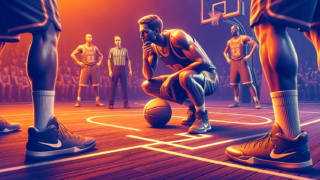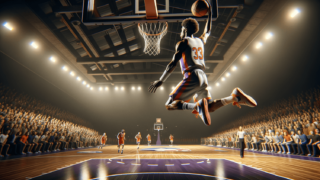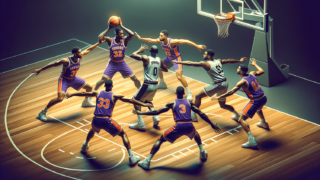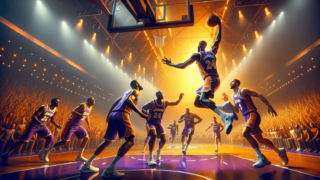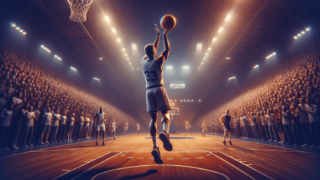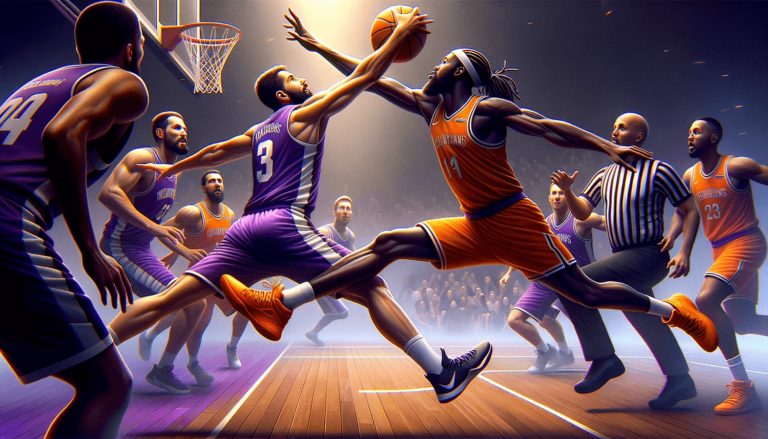
Ball-Touching Rule in Basketball
Written by: Basketball Universe
Last updated:

Have you ever found yourself watching a basketball game in awe, wondering about the secret intricacies that make this dynamic sport a true spectacle to behold? Well, look no further! It’s time to dive deep into one of the most essential yet underrated concepts of the game: the ball-touching rule. In this entertaining and informative blog post, we’ll explore every aspect of this rule, from its origin and application to how it impacts the game strategy and unfolds during the heat of the moment. So, dust off your sneakers, grab a ball and let’s unravel the mysteries of the ball-touching rule in basketball together!
Ball-Touching Rule in Basketball
The ball-touching rule in basketball primarily refers to the limits and guidelines governing the contact between players and the basketball during gameplay. Encompassing various aspects such as dribbling, passing, shooting, and rebounding, this rule helps maintain fair play and fosters proper in-game techniques. Notable instances of the ball-touching rule include avoiding ‘double dribbles’, refraining from carrying or palming the ball, and respecting the ‘three-second rule’ while in the key area. By understanding and abiding by these regulations, players ensure smooth gameplay and demonstrate excellent sportsmanship.
Mastering the Art of Dribbling
Before diving into the nitty-gritty of basketball rules, let’s start by exploring the most fundamental skill that players must acquire – dribbling. The way players touch and control the ball while dribbling is of vital importance, as missteps can lead to penalties and turnovers. So, buckle up and prepare to expand your knowledge on the art of dribbling!
The Double-Dribble Violation
A common foul seen in basketball games across all skill levels is the double-dribble violation. The rule dictates that a player cannot dribble the ball with both hands simultaneously or start dribbling again after terminating a prior dribble series with a hand on top of the ball. Committing this violation results in a turnover, with possession awarded to the opposing team. By understanding this fundamental aspect of the ball-touching rule, players can avoid unnecessary mistakes and maintain possession during the game.
Carrying the Ball
Another dribbling foul, known as carrying or palming, occurs when a player dribbles the ball and momentarily halts its rotation by allowing their hand to rest underneath it. This illegal touch gives the dribbler an unfair advantage, as they can effectively stop and start the dribble at will. The carrying violation results in a loss of possession and a turnover. Aspiring players should practice keeping their hand on top or to the side of the ball while dribbling to steer clear of this infringement.
Phenomenal Passing Techniques
One of the most exciting aspects of the game of basketball is how teammates work together to create seamless, breathtaking plays. A huge component of that teamwork is passing, which relies heavily on accurate ball-touching techniques. In this section, we’ll explore proper passing form and the associated rules that make this skill even more thrilling!
The Five-Second Closely Guarded Rule
This basketball rule encourages swift decision-making and teamwork, as players must pass or shoot the ball within five seconds if closely guarded by an opponent. The rule applies to both dribbling and stationary players holding the ball in the frontcourt. Violating this rule results in the dreaded turnover, so it’s crucial for players to hone their ability to quickly scan the court and connect with teammates.
Traveling Violation
While not strictly related to the act of passing, the traveling violation is an essential concept when discussing ball-touching rules. Traveling occurs when a player takes too many steps without dribbling, which is typically three or more. This misstep can occur before a pass or shot and often results from a player lifting their pivot foot before releasing the ball. A traveling violation promptly stops gameplay and gifts possession to the opposing team. Enhancing footwork and making clear passes to teammates on the court can eliminate this blunder from your skillset.
Scoring With Ease
Basketball is a high-scoring sport, making the scoring aspect even more significant when discussing ball-touching rules. There are specific regulations and techniques involved in shooting the ball and completing alley-oops. Let’s delve into this exciting element of the game!
Goal Tending and Basket Interference
When shooting the ball, players need to be aware of the goal tending and basket interference rules. According to these regulations, opponents cannot touch the ball when it’s in a downward trajectory towards the basket or has a chance to score. Likewise, they mustn’t touch the rim or the net when the ball is within the cylinder-shaped area above the hoop. Committing either foul awards points to the shooter, making it essential for players to refrain from interfering with potential baskets while contesting shots.
The Art of the Alley-Oop
The alley-oop play, where one player lobs the ball towards the rim for a teammate to catch and dunk, has become a fan favorite. However, it’s essential to know the ball-touching rules associated with this exhilarating move. If the receiving player catches the ball and immediately attempts a shot without landing on the ground or committing other violations, the basket is considered legal. Developing chemistry and timing between teammates is vital for executing flawless alley-oops and avoiding any rule infringements.
Rebounding and Boxing Out
Rebound battles are an integral part of basketball, as gaining possession after a missed shot can determine a game’s outcome. The ball-touching rules associated with rebounding and boxing out ensure fair competition and fantastic play. Let’s uncover the rules of engagement in this on-court struggle!
The Three-Second Rule
One rule that significantly impacts rebounding and offensive play in the key area is the three-second rule. This regulation stipulates that offensive players cannot remain in the painted area (key) for more than three consecutive seconds while their team has possession. A violation of this rule results in a turnover, and the ball is awarded to the opposing team. Abiding by this rule not only helps in avoiding penalties but also keeps the offensive gameplay dynamic, opening up opportunities for teammates on the court.
Over-the-Back Violation
Rebounds often see players outstretching and battling for the basketball while it’s in the air. While aggressiveness and determination are valuable traits, going over the back of an opponent to reach the ball is considered a violation. In this situation, the player who infringed is penalized with a personal foul, and the opponent may receive free throws if the team is in the bonus situation. Emphasizing proper positioning and boxing out skills is crucial in avoiding this violation and securing rebounds cleanly.
Restrictions on Physical Contact
In addition to the specific ball-touching rules in basketball, it’s vital to discuss the broader physical contact restrictions imposed by the game. Navigating through these regulations will ensure smooth gameplay and help players focus on demonstrating their skills on the court.
Personal and Technical Fouls
Physical altercations can negatively impact the flow of a basketball game. To mitigate this, basketball has personal and technical foul rules that govern on-court behavior. Personal fouls involve excessive physical contact, such as pushing, holding, or illegal use of hands during attempts to steal the ball. Technical fouls refer to unsportsmanlike conduct, including arguing with officials or displaying hostile behavior. Fouls can impact a team’s chances of winning, as the opposition might receive free throws or possession of the ball. Being cognizant of these restrictions is necessary for maintaining a disciplined and successful performance on the court.
The Flagrant Foul
A flagrant foul occurs when a player intentionally or recklessly makes severe contact with an opponent. Not only does this breach of the basketball rules result in free throws and possession for the opposing team, but the offending player might also be ejected from the game. Remember, while aggressiveness and competitiveness are admirable traits in basketball, they must always be accompanied by fair play and respect for opponents.
In summary, understanding and adhering to the ball-touching rule in basketball is fundamental for players at all levels. This knowledge not only ensures that gameplay is conducted fairly but also promotes proper techniques and skills development. With the information provided here, you can now confidently witness the magic of basketball, play the game with more awareness, and continue enhancing your expertise in this incredible sport!
Refining Ball-Handling Techniques
Another crucial aspect of the ball-touching rule in basketball is the refinement of ball-handling techniques. Players seeking to improve their overall gameplay and understanding should focus on the benefits of excellent ball-handling skills. This section will provide guidance on maximizing your prowess on the court by focusing on key attributes.
Hand-Eye Coordination
Good hand-eye coordination is essential for outstanding ball-handling in basketball. Players must maintain control of the ball when dribbling, passing, and shooting, all while navigating the court and keeping opponents at bay. To improve hand-eye coordination, practice various dribbling drills using both hands, work on catching passes at different angles and speeds, and try shooting from different spots on the court.
Finger Strength and Control
Excellent finger strength and control contribute to efficient ball-handling techniques. Top basketball players know the importance of finger strength in generating powerful, accurate passes and having a soft touch when shooting or making layups. Finger-strengthening exercises, like dribbling with force or using a grip strengthener, can lead to significant improvements in ball-touch skills and your overall basketball game.
Understanding the Shot Clock
The shot clock is an essential aspect of basketball that influences how players handle the ball. This time limit, set for each offensive possession, encourages swift decision-making and decisive plays. Familiarizing yourself with the shot clock rules can give you an edge and help you make smarter choices during gameplay.
24-Second Shot Clock in Professional Leagues
Top professional leagues, including the NBA and FIBA, impose a 24-second shot clock on each offensive possession. This regulation ensures an up-tempo game where teams must execute plays quickly and efficiently. To maximize your ball-handling abilities, practice shooting and passing drills under time pressure to simulate the quick pace of professional basketball.
30-Second Shot Clock in College Basketball
College basketball in the United States operates with a slightly longer shot clock of 30 seconds. Understanding the time limitations in college basketball is essential for playing within the rules and optimizing your in-game decision-making. Incorporate the 30-second shot clock into your practice sessions to build solid fundamentals and improve your ball-handling and passing techniques under pressure.
Defensive Implications of Ball-Touching Rules
It’s essential to remember that excellent ball-handling techniques are not only necessary for offensive players but also important for defenders. This section will reveal the defensive implications of the ball-touching rule in basketball.
Steals and Deflections
Defensive players can significantly impact a game using their ball-touching ability. Skilled defenders excel at stealing the ball from opponents and deflecting passes to break up the offensive flow. To improve your defensive ball-touching skills, practice drills that focus on footwork, anticipation, and quick hands. Gaining experience on this front can result in creating lucrative fast-break opportunities or forcing critical turnovers to shift the momentum of the game in your favor.
Blocking Shots
Effective shot-blocking, often the domain of taller players or those with excellent jumping ability, requires a precise understanding of the ball-touching rule. Defenders must time their jumps perfectly to avoid committing goal-tending or basket interference violations. Practice perfecting the art of the clean block by honing your timing and awareness of legal ball-touching during shot attempts, and you’ll emerge as a formidable force on the defensive end of the court.
Studying the ball-touching rule in basketball, refining your skills, and understanding both offensive and defensive implications can lead to a remarkable improvement in your game. With the knowledge presented in this article, you’re well on your way to becoming an all-around basketball enthusiast and player. Enjoy the game, and aim for continuous development of your skills both on and off the court!
Frequently Asked Questions
As you embark on your basketball journey, you may have some lingering questions related to the ball-touching rule in basketball along the way. To help you further your understanding, we’ve compiled a list of frequently asked questions with succinct answers for your convenience.
1. What is a double-dribble?
A double-dribble is a violation where a player dribbles the ball with both hands simultaneously or starts dribbling again after previously terminating their dribble series with a hand on top of the ball. This violation results in a turnover, with possession awarded to the opposing team.
2. How can I prevent carrying or palming the ball?
To avoid carrying or palming, ensure you keep your hand on top or to the side of the ball while dribbling. Practicing proper dribbling techniques and focusing on keeping a low, controlled dribble can reduce the risk of committing this violation.
3. What is the five-second closely guarded rule?
The five-second closely guarded rule states that a player must pass, shoot, or begin dribbling within five seconds if closely guarded by an opponent in the frontcourt. This rule encourages players to make quick decisions and fosters teamwork, as it penalizes slow ball movement with a turnover.
4. What is the difference between goal tending and basket interference?
Goal tending is a violation that occurs when an opponent touches the ball while it’s descending towards the basket or has a chance to score. Basket interference occurs when an opposing player touches the rim, net or the ball when it’s within the cylinder-shaped area above the basket. Both violations result in points being awarded to the offensive team.
5. What is the three-second rule?
The three-second rule stipulates that offensive players cannot remain in the painted area (key) for more than three consecutive seconds while their team has possession. If violated, a turnover occurs, and possession is awarded to the opposing team.
6. What is an over-the-back violation?
An over-the-back violation occurs when a player goes over the top of an opponent in an attempt to reach a rebound. This infraction results in a personal foul, and the opponent may be awarded free throws if their team is in the bonus situation.
7. How can I improve my hand-eye coordination for better ball-touching skills?
Practicing various dribbling drills with both hands, engaging in catch-and-pass exercises at different angles and speeds, and working on shooting from different court spots can boost your hand-eye coordination, leading to superior ball-touching skills.
8. Are there any specific fouls related to physical contact with the ball?
Yes, there are fouls related to physical contact while handling the ball, including pushing, holding, or illegal use of hands during attempts to steal the ball. Committing these fouls results in personal fouls that can lead to free throws for the opposing team.
9. Do professional leagues and college basketball have different shot clock rules?
Yes, professional leagues like the NBA and FIBA have a 24-second shot clock, while college basketball in the U.S. has a longer 30-second shot clock. Understanding these variations allows for informed decision-making during gameplay in different leagues.
10. How does knowledge of the ball-touching rule help defenders?
Defenders can use their understanding of the ball-touching rule to execute clean steals, deflections, and blocks without committing violations. This knowledge helps defenders eliminate unnecessary fouls and turnovers, benefiting their team on both ends of the court.
Featured Posts
- No pillar pages found.
